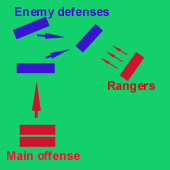|
|
||||||
|
|
||||||
With voice contact integrated, scouting will become an urgent and necessary activity. The Ranger, the class best equiped for this task, will be able to warn you of advancing enemies, and lay bare any interesting plans the enemy might have to bring about your defeat. Any team should have a or a couple of rangers. |
|
|
|
||||||
form a sortie with a marine, sniper and a machinegunner. The attack would then go as follows: the ranger draws fire by moving parallel to the front within view of the enemy to then retreat. This will allow the other operatives to detect the enemy firing positions, and from cover the will now launch a barrage. Once this barrage is over the ranger will perform the same action to see whether any are left, after which the marine, covered by the machinegunner and sniper will launch an offensive action. This action is only based on three people, but can be extrapolated to include whole squads if necessary. 4. As there will be defensive positions in the maps, such as bunkers, machinegun nests, etc. the ranger is an indispensable tool in keeping the front highly dynamic. I�ll explain this: In TF/TFC the fronts were basically static, you had two forts/bases on either side and this was basically your position. As long as you held on to this, the team could maintain some sort of status quo. However, TF2 will have larger maps, and as far as I�ve been able to pick up new playing styles. Therefore simply to send out squads from one fort to the other will become a highly time costing experience. Furthermore, in the already often discussed �Private Ryan�-scenario, it is unclear to me whether one of the teams will actually have a base. This forces of course the teams to remain mobile, and not pinned down in a certain area. You don�t want to get fragged protecting a bunker with no strategic value. As the ranger can outmanoeuvre most other classes, the tactical and strategic importance becomes high. Allthough they can only form a �light� squad, a squad of rangers will be able to apply pressure to the enemy at diverse points. 5. Use rangers for diversive action (see graphic). As stated above, the ranger can apply offensive pressure at various points within a short amount of time. Therefore a commander would be smart to decide to launch a diverionary tactic everytime an offensive is going to start. The enemy will of course react, and concentrate forces where he expects the enemy. An offense planned at point A, will of course be proceeded by an diversion offense at point B: here a combination of Rangers and Marines can disrupt any enemy troop concentration, and force an enemy commander to concentrate his troops on point B. This will weaken Point A, where the commander, when signs of weakening occur can launch the main offensive (using Sturm- or Battering ram tactics). 6. Use rangers for hornet activities or razzia-tactics. Used efectively by Arab Armies in the 7th century hornet or razzia activities can effectively disrupt any strategic planning by the enemy. The objective is not to open battle but to keep the enemy engaged and disrupted. Let a squad of light offensive troops, led by rangers, engage the enemy quickly and retreat again along the line. The enemy will get ready for defensive action, but you will be gone again. This way, a squad of five people can keep an entire team occupied by running across the map and attacking here and there. Quickly enough the enemy will know that you are not sending a large army, but if executed well enough the enemy can be slowed down for quite some time. Maybe even long enough for you to start a counter-attack. |
